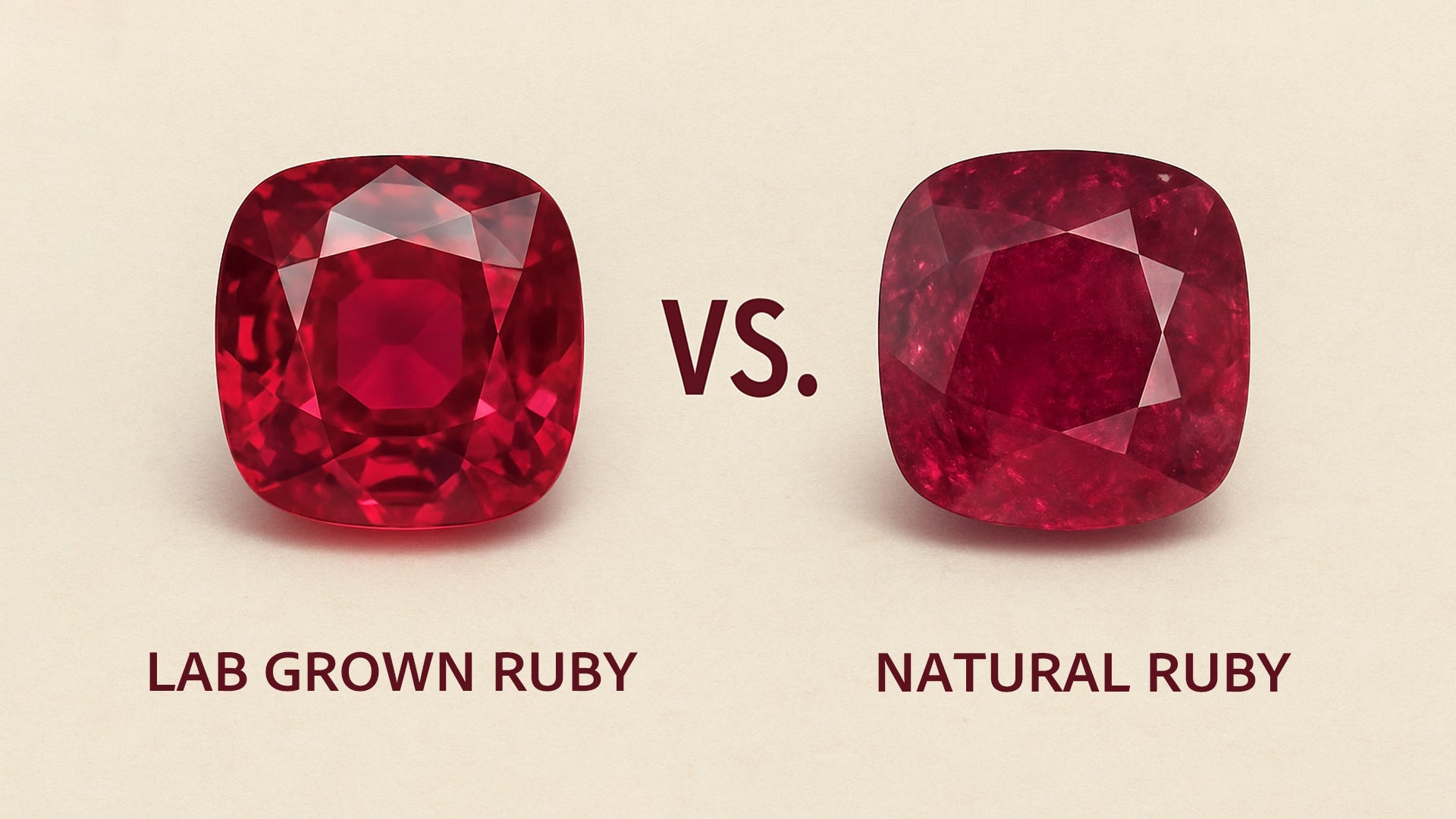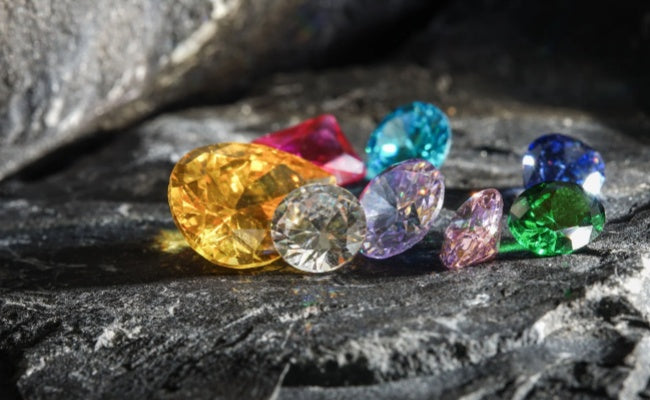
Lab Grown Ruby Vs. Natural Ruby, What is the Difference?
Rubies, prized for their fiery red color and rarity, have been coveted since ancient times and are known as the "king of gemstones". As the birthstone for July, Natural rubies symbolize love, power, and prestige, and have long been favorites of royalty and fashion elites. However, with rapid advances in modern technology, the emergence of lab-grown ruby stones offers consumers more choices. They have clear advantages in price, environmental impact, and ethical sourcing.
So what exactly is the difference between the lab-grown ruby and natural ruby? Which one is better suited to your needs? This article analyzes the characteristics, differences, and buying recommendations for both types of ruby gemstones across multiple dimensions to help you make an informed choice.
What is Lab Grown Ruby?
Lab-grown ruby, also called synthetic ruby or lab-created ruby, is created in a controlled laboratory environment by simulating the conditions under which natural rubies form. These gems have the same chemical composition (aluminum oxide, Al2O3) and crystal structure as natural rubies; the difference lies in the formation process.
Currently, there are two main methods for producing lab-created rubies:
Verneuil process: This is the most established technique for making synthetic ruby stones, invented in 1902 by French chemist Auguste Verneuil. The method involves feeding powdered material into a hydrogen-oxygen flame where it melts, then slowly cools to form a ruby stone. Rubiesmade by this process often show characteristic curved color banding, which is an important identification feature.
Flux method: This approach simulates the natural ruby formation process by dissolving raw materials, fluxes, and solvents in a flux under high-temperature, high-pressure conditions, then cooling slowly to crystallize. Ruby stones produced this way have internal structures more similar to natural rubies and generally higher quality.
There are also other methods such as hydrothermal growth. All these techniques are carried out under precisely controlled conditions, allowing human control over the ruby gem's purity, color, and size—resulting in high yields and fewer impurities.
Characteristics of lab-grown rubies:
- Pure, consistent color with far fewer inclusions commonly seen in natural rubies.
- Hardness of 9 on the Mohs scale, the same as natural rubies.
- Color depth and clarity can be precisely controlled.
- Short production cycles, typically from a few weeks to a few months.
- Generally more affordable than natural rubies.
The arrival of lab-created rubies not only meets market demand for high-quality rubies but also gives jewelry designers greater creative freedom. Because gem parameters can be precisely controlled, designers can create more innovative and personalized jewelry pieces.
It's important to emphasize that lab-grown rubies are entirely different from imitation rubies (such as glass or cubic zirconia). Imitation rubies only mimic the appearance of rubies; their chemical composition and physical properties are completely different from natural rubies.
What is a Natural Ruby?
A natural ruby is a gemstone formed deep within the Earth's crust over millions or even hundreds of millions of years under high temperature and pressure. Its main component is aluminum oxide (Al₂O₃), and it contains trace amounts of chromium (Cr) which gives the ruby its captivating red color.
Natural rubies are primarily found in places such as Thailand, Sri Lanka, Madagascar, and Mozambique. Ruby stones from different origins have distinct characteristics. Thai ruby stones tend to be darker with brownish tones; Sri Lankan ruby stones are relatively lighter in color but very bright; Madagascar ruby stones often show richer and more variable hues.
How Natural Rubies Form?
The formation of a natural ruby requires extremely special geological conditions. First, aluminum-rich rocks deep underground must undergo metamorphism under high temperature and pressure. Second, chromium must be present—chromium is the key element that gives the ruby its red color. Finally, long geological time is needed for crystals to slowly grow and mature. This process usually takes millions of years and is full of uncertainty, so every natural ruby is unique and carries its own "growth marks".
Grading Standards for Natural Rubies
The quality of natural rubies is mainly evaluated according to the 4C standard:
- Color: Color is the most important factor. A pure red color is best, while "pigeon blood" red is considered the most prized hue. If the color is too light it may be confused with sapphires, while colors that are too dark can reduce transparency and brilliance.
- Clarity: Refers to the internal cleanliness of the gemstone. Nearly all natural rubies contain inclusions; a completely flawless natural ruby is extremely rare. Common inclusions include silk-like fibers, liquid inclusions, and mineral crystals.
- Cut: A good cut maximizes a ruby gemstone’s fire and brightness. Classic cuts include round, oval, square, and cushion cuts.
- Carat Weight: The unit for rubies; 1 carat equals 0.2 grams. Large, high-quality natural rubies are very rare, and price increases exponentially with weight.
Similarities Between Lab Grown Ruby and Natural Ruby
Although their formation processes differ, lab-grown rubies and natural rubies are very similar in many respects. This is why even professional gemologists need sophisticated instruments to tell them apart.
1. Chemical Composition
Whether lab-grown or naturally formed, rubies are made of aluminum oxide (Al₂O₃) with small amounts of chromium (Cr³⁺) that give them their red color. This consistency in chemical composition means their basic physical and chemical properties are the same.
2. Physical Properties
Lab rubies and natural rubies reach a hardness of 9 on the Mohs scale, giving them excellent wear resistance. Their specific gravity, refractive index, and birefringence are also basically identical, making them almost indistinguishable in appearance. In everyday wear, consumers are unlikely to notice differences with the naked eye.
3. Visual Effects
With proper cutting and polishing, both lab and natural rubies display stunning red color and brilliance. Both can range from transparent to translucent. When set in jewelry, they produce similar visual impact and aesthetic value.
4. Suitability for Use
From a jewelry-making perspective, lab-grown and natural rubies have the same working properties. Both can be cut, polished, and set, and are suitable for all types of jewelry, including ruby rings, earrings, necklaces, and bracelets.
5. Maintenance
Because their physical and chemical properties are the same, care and maintenance practices are identical. Both should avoid strong impacts, be cleaned regularly, and be kept away from harsh chemicals. In daily wear and care, you do not need to treat them differently.
Differences Between Lab Grown Ruby and Natural Ruby
Although lab-grown rubies and natural rubies can look and perform almost identically in basic properties, there are still important differences between them. These differences are not only technical but also affect market value and consumer perception.
1. Formation Process
The most fundamental difference lies in how they form. Natural rubies form deep within the Earth over millions of years through geological processes; each stone records a unique geological history and natural beauty. Synthetic rubies, by contrast, are produced in controlled, artificial environments using scientific techniques over a relatively short period. This difference in formation gives each type a different "identity" and value implication.
2. Inclusion Characteristics
Professional gemologists distinguish the two kinds of rubies by examining their inclusions. Natural rubies often trap surrounding minerals, fluids, or gases during formation, producing distinctive inclusions—commonly needle-like rutile, liquid inclusions, healed fractures, amphibole crystals, and so on. These inclusions act like a gemstone's "ID", serving as important evidence of natural origin.
Lab-created rubies usually have few inclusions or inclusions that exhibit artificial characteristics. Flame-fusion (Verneuil) synthetic rubies are typically very clean internally, with almost no inclusions; if present, they're often gas bubbles or curved growth lines. Flux-grown rubies may contain remnants of flux, and those inclusions look different from natural ones.
3. Color Distribution
Natural rubies usually have uneven color distribution and may show color zoning or patches—another sign of natural origin. Lab rubies, because they grow in stable conditions, often show very uniform color and can appear "perfect" to the naked eye.
4. Growth Structure
Under high-power magnification, you can see differences in growth structures. Natural rubies typically show straight or slightly curved growth lines, reflecting slow crystal growth in natural environments. Growth structures in lab-created rubies depend on the manufacturing method: flame-fusion rubies show curved growth lines, while flux-grown rubies may display angular growth structures.
5. Fluorescence Responses
Natural rubies may fluoresce under ultraviolet light depending on their locality and trace elements. Many synthetic rubies are intentionally doped with higher chromium content to mimic natural color, which can make them fluoresce very strongly under UV light.
6. Price and Investment Value
In the traditional jewelry market, natural ruby gemstones still dominate, especially among collectors and investors. Natural rubies—particularly high-quality, untreated stones—hold strong value and appreciation potential. A natural ruby with vivid color, high clarity, and substantial carat weight is extremely rare, commands a high price, and often serves as a store of value. Top-tier natural rubies that reach "pigeon blood" quality can cost astronomical amounts.
Lab-grown rubies are typically priced at only 10%–30% of a comparable natural ruby. This price gap stems largely from the fact that lab rubies are not rare and can be produced in quantity. Lab-created rubies function more like consumer goods: they satisfy the desire for a beautiful ruby appearance but generally lack investment and collectible value.
7. Environmental and Ethical Considerations
From an environmental perspective, lab-created rubies have clear advantages. Mining natural rubies can involve environmental damage and labor exploitation, raising ethical concerns similar to those associated with blood diamonds and "blood gems". Lab-created rubies are produced in a more environmentally friendly process and are considered a more sustainable and ethical alternative. For consumers concerned about environmental and humanitarian issues, lab-grown rubies can be a more attractive choice.
Lab-Grown Vs. Natural Ruby, Which is the Best?
Choosing between lab-grown and natural rubies mainly depends on your personal needs, budget, values, and intended use.
Budget Considerations
If you have a limited budget but still want high-quality ruby jewelry, lab-grown rubies are clearly the better choice. With the same budget, you can buy larger, cleaner, and more richly colored lab rubies. This is especially relevant for younger buyers or those purchasing ruby jewelry directly.
Use and Occasion
For everyday jewelry, lab-grown rubies are ideal. They offer the same gemstone appearance and options as natural rubies but are more affordable, and accidental damage won't cause a serious financial loss. For important occasions—such as engagement rings, wedding rings, or heirlooms—some buyers may prefer natural rubies because they carry symbolic meaning.
Investment and Collectible Value
If your purpose in buying a ruby includes investment or collecting, natural rubies—especially high-quality ones—are usually the better choice. Historical data shows that top-quality natural rubies have solid value retention and appreciation potential, particularly large stones from well-known origins with authoritative certifications.
Environmental and Ethical Considerations
More and more consumers care about the environmental and ethical aspects of jewelry. If you value environmental protection and ethical sourcing, synthetic rubies are the better option. Their production does not involve mining, has minimal environmental impact, and avoids potential issues related to processing and conflict minerals.
Personal Values and Emotional Needs
Some buyers feel that only a natural ruby can truly represent eternity and rarity because it formed through long natural processes. Others view lab-grown rubies as symbols of technological progress and a rational choice. This decision often reflects personal values and what jewelry means to the individual.
LUO Jewelry Lab-Grown Ruby Jewelry
In the field of lab-grown rubies, LUO Jewelry has gained wide recognition for its pursuit of excellent quality, superb craftsmanship, and innovative design. As an industry-leading brand, LUO Jewelry is committed to offering you high-quality lab-created ruby jewelry. Each lab-created ruby we offer is carefully selected to ensure it meets the highest quality standards.
At LUO Jewelry, we offer lab-grown ruby rings, lab-grown ruby earrings, and lab-grown ruby necklaces. In addition to our existing collections, we provide professional custom services. You can choose the ruby’s color and cut, as well as the metal setting and any engravings, creating a one-of-a-kind ruby jewelry piece that belongs to you.
Lab-grown Ruby Ring Collection
Our lab-grown ruby ring collection features refined and diverse designs. Classic styles include the simple six-prong setting that highlights the ruby’s striking beauty; glamorous halo designs with small diamonds surrounding the center stone to enhance overall sparkle; and vintage-inspired designs that incorporate art-deco elements to express unique personality and charm.
Our engagement ring collection is particularly recommended. We use top-quality lab-grown rubies as center stones paired with carefully selected diamond accents to create engagement rings that are both romantic and practical. These rings capture the beauty of natural rubies at a more approachable price, allowing young couples to own the ruby engagement ring of their dreams.
Lab-grown Ruby Earring Collection
Our lab-grown ruby earring collection showcases the brand’s design innovation. Simple stud designs are perfect for daily wear—selected rubies set in platinum or 18K gold are elegant yet lively. Drop earrings are more glamorous and suitable for formal occasions; their flowing lines and sparkling rubies complement each other beautifully.
Lab-grown Ruby Necklace Collection
Our lab-grown ruby necklace collection ranges from minimalist to luxurious, covering various styles and price points. Single-ruby pendant necklaces are simple and elegant, suitable for everyday outfits. Multi-stone necklaces are more opulent and showcase the charm of clustered ruby settings.
Conclusion
Lab-grown rubies and natural rubies are very similar in chemical composition, physical properties, and visual appearance. Their main differences lie in the formation process, inclusion characteristics, color distribution, growth structure, fluorescence response, price and value, and environmental considerations.
When choosing, if you value rarity, investment potential, and the unique beauty of a natural stone, then a natural ruby is the best choice for you. If you prioritize a beautiful appearance, want a finely crafted piece of jewelry at a more affordable price, and care about environmental sustainability, then a lab ruby is an excellent option. As a leading brand in the lab-grown ruby field, LUO Jewelry can meet your different needs and help you own your own ruby beauty.
In short, the comparison between lab-created rubies and natural rubies is not about "real" versus "fake", but a choice between "natural" and "man-made", and between "rarity" and "renewability". What matters most is not where the ruby comes from, but whether it can bring you aesthetic pleasure and emotional satisfaction.

